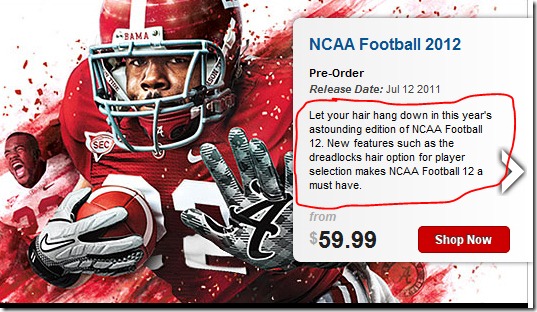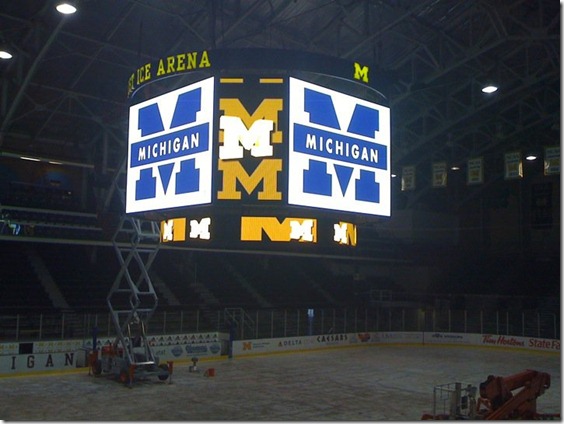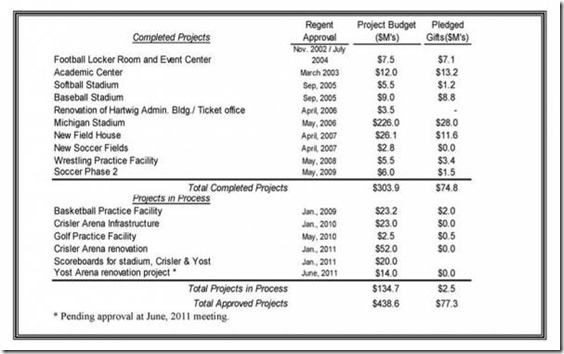lolea
Why I stopped buying NCAA in two sentences. Go:
Also this is definitely because of Denard.
Hockey bits. It was announced a while ago but in case you missed it, Big Ten hockey has adopted a fairly sensible playoff format. The bottom four finishers have a best two-of-three series at the higher seed's home ice and then there is a four-team single-elimination playoff on the #1 seed's home ice.
It's a little strange that the second-place finisher gets zero home hockey games but it could have been worse. I still prefer best two-of-three series the whole way because it's more hockey and less arbitrary.
Other logistical bits continue to filter out:
- Teams have "already been asked" to play two Monday night games per season and Wednesday games between nearby teams have also been broached. The article also mentions the possibility of some Sunday-Monday series.
- The Big Ten "will" reach a scheduling agreement with the WCHA that will take care of "perhaps eight" of the new Big Ten's 14 nonconference games.
- They might have to move the state basketball championships in Wisconsin.
I expect the WCHA scheduling agreement just involves Minnesota and Wisconsin. Having the WCHA suck up the eight extra nonconference games now on OSU's, MSU's, and Michigan's schedules would hurt the CCHA further, and I'd rather to see them play traditional opponents like Miami, Northern Michigan, Ferris, etc., than fly to Minnesota to play St. Cloud.
As far as moving games for television goes, I'm all for the increased exposure but when I looked at the schedules it seemed like Sunday was a vast wasteland for basketball that hockey could fill. Is the NFL that much of a beast?
Meanwhile, it is alive:
Illini, probably not. A Champaign-Urbana developer is planning a $15 million ice arena with two sheets of ice in a 100k square-foot building. This immediately got message board folk speculating about Illini hockey, but it doesn't sound like that kind of investment is anywhere near what you'd need for a D-I program. Illinois would probably have to spend at least double that to get a proper D-I rink. Add in a former club player's perspective…
Even though the club team has operated at a profit and has the third highest game attendance per season of all sports on campus (average 800-1000 per game with an all time high of around 2000), there are still too many things standing in the way for Illinois to field a D1 NCAA hockey team in the near future. Using the current ice rink for a D1 team is not an option due to the fact that the NCAA requires a minimum seating capacity of 4k-5k for all new D1 NCAA hockey teams (seating capacity at the current rink is ~1250) and the rink is not regulation size. Another problem is that while hockey may have proved that it is in demand in C-U, it is pretty far down the list of sports the AD would like to add. Mens swimming and men's soccer are both sports that could be added to the Illinois AD for significantly less money and without having to add new facilities to the university.
… and it sounds like if the Big Ten adds a seventh member in hockey it won't be the Illini unless they get a Terry Pegula-level donation.
One wing forward extra crispy. It seems like basketball might have its two-ish open spots for the 2012 and 2013 classes filled promptly, what with Flint's Monte Morris declaring Michigan his leader, albeit only from the four teams who have offered, and August($) his decision timeframe. Meanwhile, Indiana's Zak Irvin is stepping up his campus visits considerably. He says he's not going to make an immediate decision but it doesn't sound like he's going to wait that long:
“Right now I’m just taking my time with it,” he said. “I don’t think I’m going to do anything soon. I’m just reviewing all my options.”
In addition to Butler and Michigan, Irvin also has offers from Baylor, Illinois, Indiana, Miami (Fla.), Michigan, Purdue and Xavier. Asked about his recent offers, Irvin said he “likes both coaching staffs” of Butler and Michigan.
“I’m still curious to see who comes out in July,” Irvin said of next month’s evaluation period. “I doubt anything happens before the
Irvin told Sam Webb that rumors a Michigan commitment was imminent were false and that "there are other schools" on his list.
Irvin's now being listed at 6'7" some places, FWIW. He'll be Sim Bhullar by the time he hits campus. Glenn Robinson III teammate Mitch McGary is also scheduled to be on campus shortly but probably remains a longshot.
Austin Hatch's situation makes Michigan's recruiting even more complicated. It will be a while before it's clear whether he can play basketball at a high level again. While I assume the NCAA will work something out so he can attend Michigan either way, there's uncertainty there. That's in the triple digits about "things you should care about related to Austin Hatch," of course.
The cheddar issue. The Business of College Sports highlights Michigan's massive construction projects:
That is a lot of money being spent on buildings that only indirectly benefit student-athletes:
As you can see, gifts help make these capital projects possible, but they only make a small dent in the total amount needed. The athletic department has incurred debt for a number of the projects and has budgeted $13.2 million in expenses for this debt service for the coming year. This is up $2.2 million from last year due to debt incurred for the Michigan Stadium and Crisler Arena projects.
In addition to this debt service, Michigan has another $14.4 million budgeted for “Facilities Expenses” and a “Deferred Maintenance Fund Transfer”. I should point out that $4.5 million of the $14.4 million mentioned is for the “Deferred Maintenance Fund Transfer”. This is a fund set up during the 2003 fiscal year that is being built up to fund future “major repair and rehabilitation projects” for athletic facilities. Because Michigan turns an operating profit each year, they’re able to put aside for future capital projects in ways I’m sure many other universities cannot.
The $14.4 million I just detailed on top of the $29.9 million set aside for renovations to Crisler and Yost and $13.2 million in debt service on facilities adds up to $57.5 million Michigan is spending next year on facilities alone.
When we point at the surpluses run by large athletic departments and say some of that money could go to athletes we should also keep in mind that if facilities are going to be kept up to date colleges have to make that happen themselves. They can't extort local governments for stadiums, so they have to build up reserves and carefully plan ahead.
The insane future. Braves and Birds has hopped on the promotion and relegation bandwagon, proposing a two-tier SEC that's not entirely dissimilar from my tortured attempts to turn the hypothetical Mega Big Ten people were tossing around last summer into an actual conference instead of two conferences glommed together.
My tortured attempt was tortured largely because I was trying to find a way to prevent the Auburn problem. Auburn was 2-6 in conference in 2008 and 3-5 in 2009. They would have been in the second division of the SEC. In 2010 they were the best team in the country. An outright promotion/relegation system would have seen that team unable to compete for a conference title at all. That seems unacceptable, and that makes a straight system like B&B proposes unworkable. This doesn't affect soccer much because the top division is 18 or 20 teams—the chance the next tier down actually contains the best team is tiny. Not so much when you have smaller numbers and rapid turnover.
The only place I think a straight promotion and relegation system might work in CFB is with the Mountain West and assorted other teams. Right now they're on the verge of an automatic BCS bid, but they'll drop out of that after the TCU, Utah, and BYU departures are accounted for. If they had an eight-team top division and rounded up the WAC/Sunbelt/etc to comprise a lower division they could assure themselves the SJSUs of the world wouldn't drop their average rating while automatically sucking the strongest teams into a group of eight that just might qualify.
Meanwhile, I think I came to the conclusion that the only way a super-conference works is if you use dynamic scheduling (i.e., play part of the season and figure out the rest of the schedule after that). If you play half the conference slate, then have teams with good records play each other while the teams with bad records do the same, you can get enough interaction between the top teams to actually feel like 16 teams are a coherent whole.
Etc.: Shawn Hunwick (and a couple of Michigan athletes you're probably less familiar with) get their charity on. Fulham, a soccer club in London, inexplicably has a Michael Jackson statue in front of Craven Cottage, and now they're selling equally inexplicable merchandise related to it. OH DE Chris Wormley says Michigan leads. TTB talks to Desmond Morgan.



28